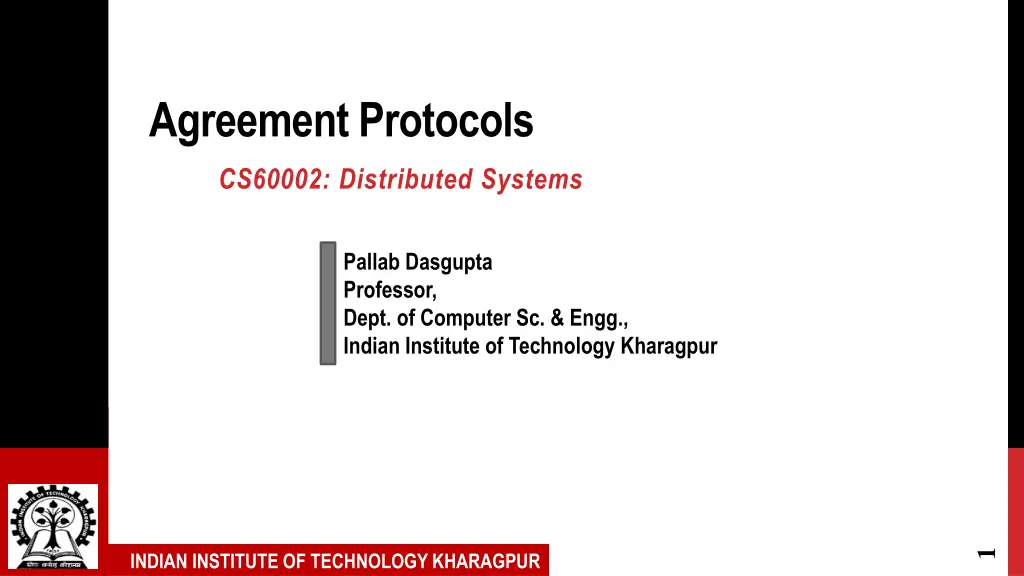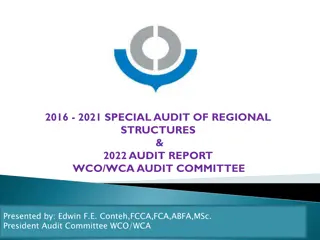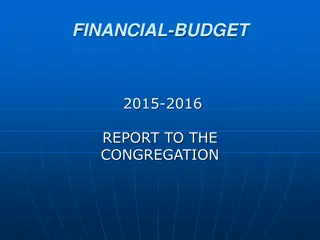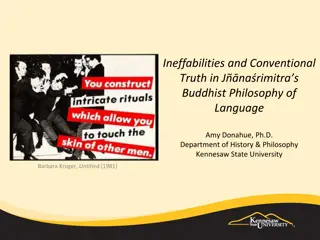
Understanding Fault Tolerance in Distributed Systems
Explore fault tolerance mechanisms in distributed systems, covering fault classification, tolerance types, core problems, consensus results, and algorithms. Learn about fault types, masking systems, agreement protocols, clock synchronization, and more to enhance system reliability and resilience.
Download Presentation

Please find below an Image/Link to download the presentation.
The content on the website is provided AS IS for your information and personal use only. It may not be sold, licensed, or shared on other websites without obtaining consent from the author. If you encounter any issues during the download, it is possible that the publisher has removed the file from their server.
You are allowed to download the files provided on this website for personal or commercial use, subject to the condition that they are used lawfully. All files are the property of their respective owners.
The content on the website is provided AS IS for your information and personal use only. It may not be sold, licensed, or shared on other websites without obtaining consent from the author.
E N D
Presentation Transcript
Agreement Protocols CS60002: Distributed Systems Pallab Dasgupta Professor, Dept. of Computer Sc. & Engg., Indian Institute of Technology Kharagpur 1 INDIAN INSTITUTE OF TECHNOLOGY KHARAGPUR
Classification of Faults Based on components that failed Program / process Processor / machine Link Storage Clock Based on behavior of faulty component Crash just halts Failstop crash with additional conditions Omission fails to perform some steps Byzantine behaves arbitrarily Timing violates timing constraints 2 INDIAN INSTITUTE OF TECHNOLOGY KHARAGPUR
Classification of Tolerance Types of tolerance: Masking system always behaves as per specifications even in presence of faults Non-masking system may violate specifications in presence of faults. Should at least behave in a well-defined manner Fault tolerant system should specify: Class of faults tolerated What tolerance is given from each class 3 INDIAN INSTITUTE OF TECHNOLOGY KHARAGPUR
Core problems Agreement (multiple processes agree on some value) Clock synchronization Stable storage (data accessible after crash) Reliable communication (point-to-point, broadcast, multicast) Atomic actions 4 INDIAN INSTITUTE OF TECHNOLOGY KHARAGPUR
Overview of Consensus Results Let f be the maximum number of faulty processors. Tight bounds for message passing: Crash failures Byzantine failures f + 1 f + 1 Number of rounds f + 1 3f + 1 Total number of processors Message size polynomial polynomial 5 INDIAN INSTITUTE OF TECHNOLOGY KHARAGPUR
Overview of Consensus Results Impossible in asynchronous case. Even if we only want to tolerate a single crash failure. True both for message passing and shared read-write memory. 6 INDIAN INSTITUTE OF TECHNOLOGY KHARAGPUR
Consensus Algorithm for Crash Failures Code for each processor: v := my input at each round 1 through f+1: if I have not yet sent v then send v to all wait to receive messages for this round v := minimum among all received values and current value of v if this is round f+1 then decide on v 7 INDIAN INSTITUTE OF TECHNOLOGY KHARAGPUR
Correctness of Crash Consensus Algo Termination: By the code, finish in round f + 1. Validity: Holds since processors do not introduce spurious messages if all inputs are the same, then that is the only value ever in circulation. 8 INDIAN INSTITUTE OF TECHNOLOGY KHARAGPUR
Correctness of Crash Consensus Algo Agreement: Suppose in contradiction pj decides on a smaller value, x, than does pi. Then x was hidden from pi by a chain of faulty processors: round f round f+1 round 1 round 2 q1 q2 qf qf+1 pj pi There are f + 1 faulty processors in this chain, a contradiction. 9 INDIAN INSTITUTE OF TECHNOLOGY KHARAGPUR
Performance of Crash Consensus Algo Number of processors n > f f + 1 rounds n2 |V| messages, each of size log|V| bits, where V is the input set. 10 INDIAN INSTITUTE OF TECHNOLOGY KHARAGPUR
Lower Bound on Rounds Assumptions: n > f + 1 every processor is supposed to send a message to every other processor in every round Input set is {0,1} 11 INDIAN INSTITUTE OF TECHNOLOGY KHARAGPUR
Byzantine Agreement Problems Model : Total of n processes, at most m of which can be faulty Reliable communication medium Fully connected Receiver always knows the identity of the sender of a message Byzantine faults Synchronous system In each round, a process receives messages, performs computation, and sends messages. 12 INDIAN INSTITUTE OF TECHNOLOGY KHARAGPUR
Byzantine Agreement Also known as Byzantine Generals problem One process x broadcasts a value v Agreement Condition: All non-faulty processes must agree on a common value. Validity Condition: The agreed upon value must be v if x is non-faulty. 13 INDIAN INSTITUTE OF TECHNOLOGY KHARAGPUR
Variants Consensus Each process broadcasts its initial value Satisfy agreement condition If initial value of all non-faulty processes is v, then the agreed upon value must be v Interactive Consistency Each process k broadcasts its own value vk All non-faulty processes agree on a common vector (v1,v2, ,vn) If the kthprocess is non-faulty, then the kth value in the vector agreed upon by non-faulty processes must be vk Solution to Byzantine agreement problem implies solution to other two 14 INDIAN INSTITUTE OF TECHNOLOGY KHARAGPUR
Byzantine Agreement Problem No solution possible if: asynchronous system, or n < (3m + 1) Lower Bound: Needs at least (m+1) rounds of message exchanges Oral messages messages can be forged / changed in any manner, but the receiver always knows the sender 15 INDIAN INSTITUTE OF TECHNOLOGY KHARAGPUR
Proof Theorem: There is no t-Byzantine-robust broadcast protocol for t N/3 S S 0 1 0 1 0 0 1 1 0 1 0 1 T U U T Scenario-0: T must decide 0 Scenario-1: U must decide 1 S Scenario-2: -- similar to Scenario-0 for T -- similar to Scenario-1 for U -- T decides 0 and U decides 1 1 0 0 1 0 1 T U 16 INDIAN INSTITUTE OF TECHNOLOGY KHARAGPUR
Lamport-Shostak-Pease Algorithm Algorithm Broadcast( N, t )where t is the resilience For t = 0, Broadcast( N, 0 ): Pulse 1 INDIAN INSTITUTE OF TECHNOLOGY KHARAGPUR The general sends value, xg to all processes, Receive messages of pulse 1. The general decides on xg. Lieutenants decide as follows: if a message value, x was received from g in pulse-1 then decide on x else decide on udef the lieutenants do not send. 17
Lamport-Shostak-Pease Algorithm contd.. For t > 0, Broadcast( N, t ): Pulse t +1 Receive messages of pulse t +1. The general decides on xg. For lieutenant p: A decision occurs in Broadcastq( N 1, t 1 ) for each lieutenant q Wp[q] = decision in Broadcastq( N 1, t 1 ) yp = max (Wp) Pulse 1 The general sends value, xg to all processes, the lieutenants do not send. Receive messages of pulse 1. Lieutenant p acts as follows: if a message value, x was received from g in pulse-1 then xp = x else xp = udef ; Announce xp to the other lieutenants by acting as a general in Broadcastp( N 1, t 1 ) in the next pulse INDIAN INSTITUTE OF TECHNOLOGY KHARAGPUR 18
Features Termination: If Broadcast( N, t ) is started in pulse 1, every process decides in pulse t + 1 Dependence: If the general is correct, if there are f faulty processes, and if N > 2f + t, then all correct processes decide on the input of the general Agreement: All correct processes decide on the same value The Broadcast( N, t ) protocol is a t-Byzantine-robust broadcast protocol for t < N/3 Time complexity: O( t + 1 ) Message complexity: O( Nt) 19 INDIAN INSTITUTE OF TECHNOLOGY KHARAGPUR






















